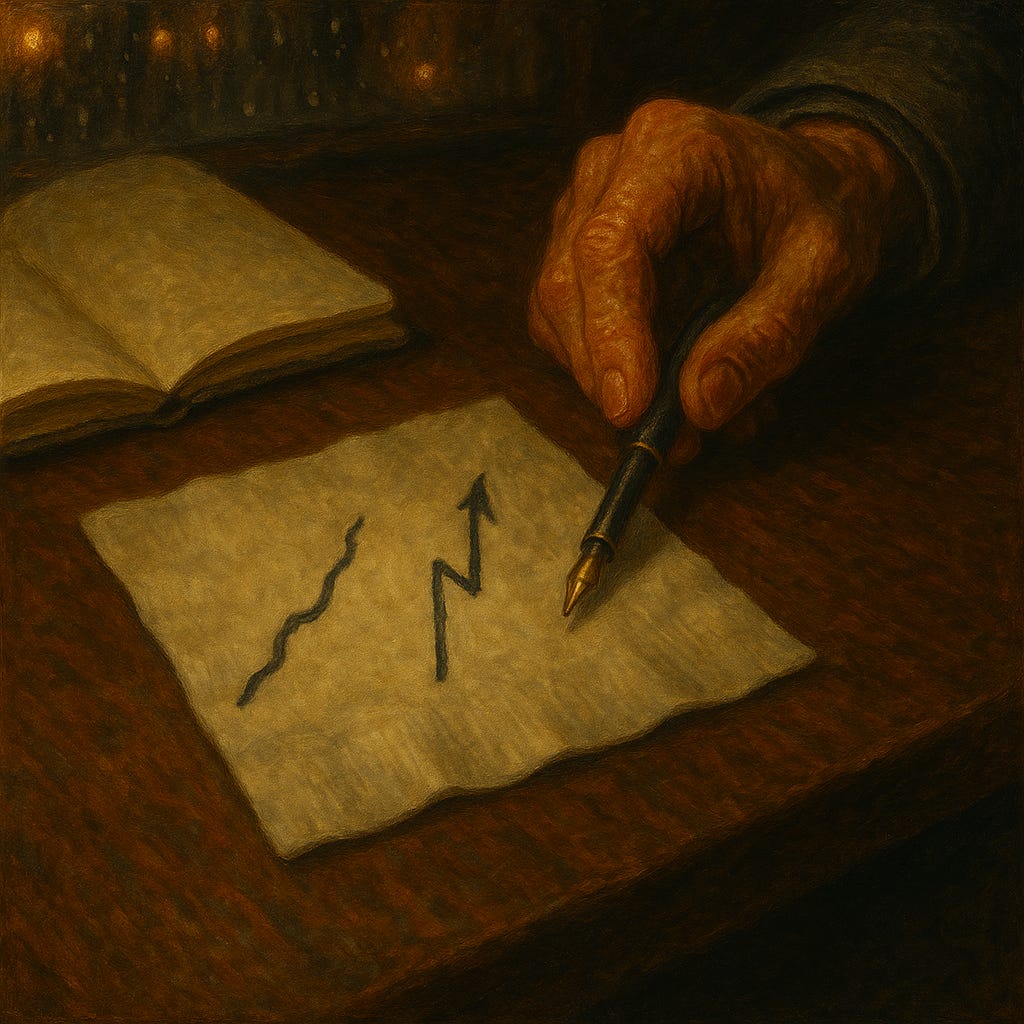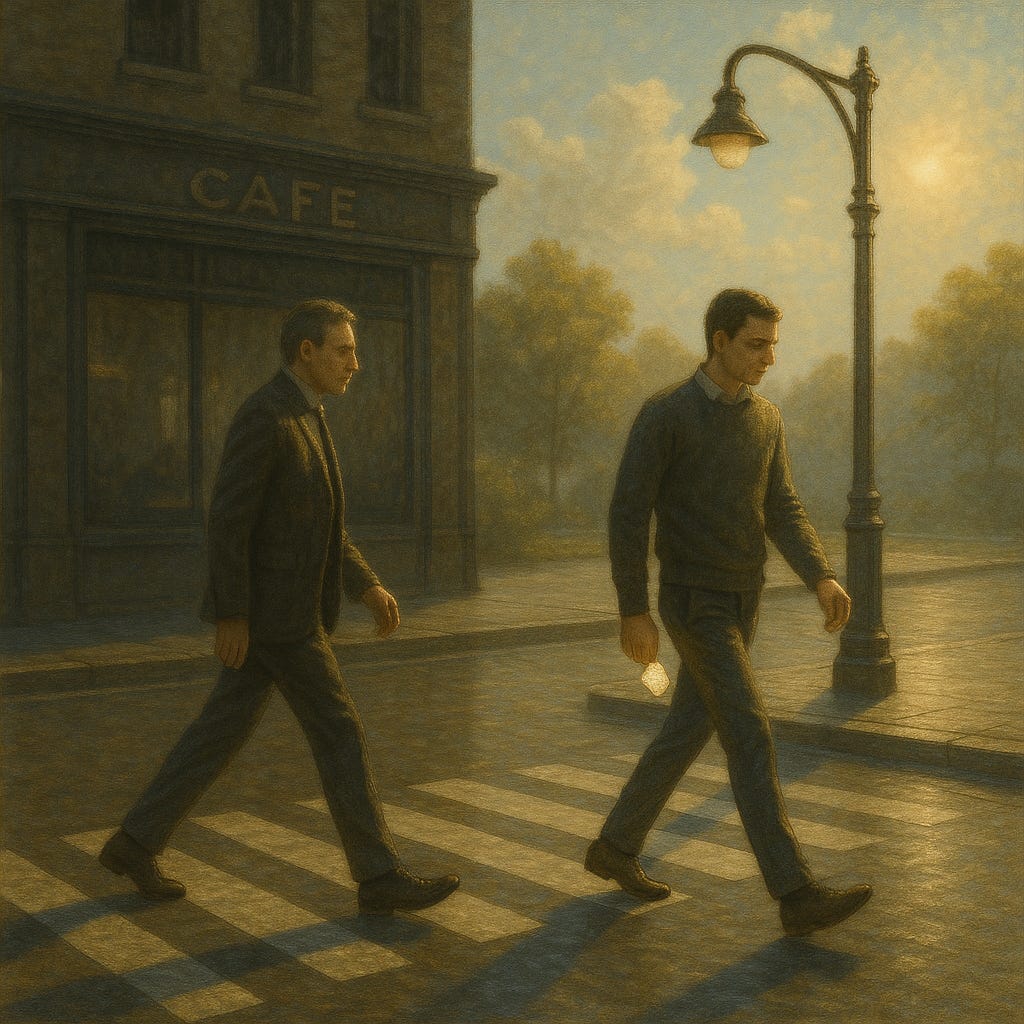Timing the Market or Owning the Business? The Eternal Investor’s Dilemma
An investing parable on one of investing’s oldest debates
Sometimes a conversation sticks with you longer than you expect. Last night, I found myself deep in discussion with an investing friend about two very different approaches to markets: sidestepping drawdowns versus enduring them in the service of long-term compounding.
The back-and-forth had the feel of a timeless debate – one that’s resurfaced in every cycle, from the Nifty Fifty to the dot-com bust to the financial crisis.
As we talked, I kept thinking that the contrast between our views would make for an engaging story, one that could illustrate not only the arguments but also the psychology behind them.
That’s where today’s post comes in. And I got a little creative here. Instead of presenting our exchange directly, I’ve taken a different route. With the help of AI, I’ve reimagined the discussion as a fictional, narrative-driven scene – almost like a chapter from a novel. The characters are imagined, but the ideas and arguments are real, drawn from the heart of our conversation. Admittedly, the story got a bitte little and would probably need more streamlining, but this is more of an experimental post anyway. I’m curious to hear what you think. Don’t expect this format to become a regular feature of the blog, but I thought it would be fun – and perhaps illuminating – to explore the two investing concepts in a more creative way.
The Night We Drew Two Maps on a Napkin
I met Victor on a Wednesday that smelled like rain. The café had almost emptied, lights dimmed to that amber tone that makes you think thoughts you don’t say out loud during the day. He arrived wearing the expression of a man who has seen three cycles and buried two of them. I’d invited him because I wanted to test my own convictions. He came because he wanted to test gravity. We took the back corner table by the fogged window. The barista had already stacked chairs on tables, leaving ours alone, as if sensing the conversation would need room to breathe. Victor invested like a chess player who always saw five moves ahead and sometimes walked off the board altogether. I tend to hold my pieces until the endgame, trusting that the pawns grow meaner as the board empties.
Between us sat a napkin, a pen, and a question that keeps coming back every decade: do you sidestep the storm or build a house that can take the wind
He began without a greeting. “At scale,” he said, “drawdowns are not marks on a chart. They are years you don’t get back.” He tapped the napkin like it owed him money. “If the next bear is anything like the last true ones, most things go down together. Correlations climb. Liquidity vanishes. You sell what you can, not what you want. You can hold quality and still get your face ripped off.”
The rain pressed harder against the window. It made the streetlights smear. I told him I’ve learned to care less about whether a quote is green next quarter and more about whether the business will earn more five years from now. Volatility bothers me in the way turbulence bothers a seasoned pilot: irritating, sometimes scary, but irrelevant to the destination if the plane is sound. “I don’t have clients who need the money next quarter,” I said. “I have the luxury of time. The error I fear is selling a fantastic business with great long-term expected returns at 12x earnings – way too cheap! – only to watch it compound for a decade while I sit in cash, realizing I’m an idiot because I never re-entered at 9x earnings.”
Victor smiled like people do when they hear a language they once spoke fluently. “We’re not that different,” he said. “I care about long-term compounding as much as anyone. I just think compounding works best when you allow it to avoid amputations. A -50% is not the inverse of a +50%. You need a +100% just to break even. That arithmetic is cruel and silent. It waits decades to punish you.”
I asked him what he was actually willing to do, in real time, to sidestep. He said he would sell. Not trim. Not rebalance. Sell. “I don’t keep score in multiples,” he said. “I keep score in survival. If I smell forced sellers coming, I move to the other side of the table. If I’m wrong, I buy back. If I’m right, I buy back lower. The cost of being early is smaller than the cost of being stubborn.”
I told him stubbornness isn’t the only alternative. There’s also humility. There’s the acknowledgment that you and I don’t get advance notice on where the bottom is or how long the storm lasts. There’s the quiet recognition that many fortunes were not built by perfectly timed exits but by imperfectly timed persistence in exceptional businesses.
He shrugged. “Fortunes were also protected by sitting out the worst innings.”
We fell into a silence that lasted long enough to become a third character at the table. The café’s espresso machine hissed like a distant locomotive.
It was the right time to talk about ghosts.
I said that I keep a running conversation in my head with three people: one who bought early, one who sold early, and one who never touched the account. The first one tends to be the hero in bull markets. The second writes the letters that survive in textbooks. The third is the dull one who ends up strangely rich at 70. Bull markets make the first two loud. Bear markets reveal exactly how much the third was paying attention.
“What about the era when value funds got dragged down with the rest,” Victor asked. “You remember how the ‘cheap’ names didn’t save anyone when the tide went out. If the indices halve, the portfolio that falls forty percent still feels like losing a year of your life.”
More silence…
I told him I don’t worship low multiples. I worship the engine that creates cash without needing fresh equity or wishful thinking. If the engine is intact and the valuation isn’t cheap in my book, my first instinct is not to sell because other people are frightened or could be frightened. My instinct is to re-underwrite. Confirm the unit economics. Talk to a customer if I can. Look for the crack in the story that isn’t in the chart yet. Invert. Always invert my grandfather taught me.
Victor leaned forward. “And if your re-underwriting is fine, and it still falls 50%…?”
I said then the long-term expected return improved, too. It’s only paper losses then.
He shook his head. “You’re thinking like an owner. Markets are public for a reason. Public markets provide liquidity for you to exploit. And markets change behavior. Quickly. Not yours perhaps, but investors are human. If you steward outside capital, the market’s erratic behavior can affect you. You sleep less. You start rationalizing sales to stop the pain. When we discuss strategy, we forget the biology. Drawdowns hijack the nervous system. They break process and turn patience into a slogan people can’t live by. You can talk about your time horizon all you want. In practice, people capitulate. Everyone’s a long-term investor … until they start seeing red!”
I didn’t argue. I have the scars too. There was a year when I watched a position I knew cold get marked down daily for weeks. I stopped opening my brokerage app in public places because my face betrayed me. I remember how many calls I ignored. I remember the moment I almost became a tourist in my own process. Everyone writes about compounding as a math trick. It is also a psychological contest. The prize is not a rate of return. It is the right to keep your method under duress.
Victor uncapped the pen and drew two lines on the napkin. One was a steady upward slope with jagged, shallow dips. The other was stair-steps: flat, then a drop avoided, then a jump up from buying lower, then flat again. “This is me,” he said, pointing to the stairs. “I give up some of the smoothness and some of the trivial rallies to avoid getting trapped in a basement that takes half a decade to crawl out of.”
I took the pen and drew a third line – volatile, a few scary drops, but the slope steeper by the end because the business it represents kept compounding capacity per share. “This is me,” I said. “I’ll take the turbulence for the slope. I can live with a 3x earnings quote for a while if the earning power is increasing by 25% annually for ten years and the capital allocation is sane. Selling because I’m embarrassed by optics is not a game I want to play.”
He nodded, not as agreement but as recognition that we were finally talking about temperament instead of truth. “You’re arguing for identity,” he said. “I’m arguing for arithmetic. For optimizing rate of return. Squeezing out another 1-2 percentage points.”
We traded stories like swap dealers. He told me about an investor he admired who hadn’t had a down year in a decade. “That’s not magic,” he said. “It’s positioning. It’s not marrying anything the market can take away from you in a week. It’s knowing where the exits are, watching the signs, walking sometimes before the music stops. People love to mock market timing until the building’s on fire.”
I countered with the investors I admire who kept positions through multiple panics because their hurdle was simple: is the expected IRR today better than yesterday? They asked fewer questions about the next quarter’s beta and more about the next decade’s capacity to reinvest at high returns. “Holding isn’t laziness,” I said. “It’s a refusal to swap a high-conviction decision for a low-conviction one simply because screens are red. And if I sell, what exactly replaces it? Which opportunity cost am I choosing on purpose?”
Victor countered that the opportunity cost during a crash is time. The time you forfeit to claw back to where you were. “If you step aside,” he said, “you buy back not only shares at a lower price but also years of extra compounding required if you missed the timming. Your financial ambitions? It will take much longer to reach them.”
The barista turned the music down to a whisper and started mopping. Outside, the rain softened to a mist. Victor asked the question that draws a fault line through every portfolio discussion: “If you knew a serious drawdown was coming, would you act differently?”
I said certainty is the one thing I never get. What I get is a siren of signal mixed with noise. I’ve tried to build a life where my process doesn’t require me to be right on the siren’s timing.
He wasn’t satisfied. “But you must have triggers,” he insisted. “You must have a level where selling is not betrayal but prudence.”
I told him my triggers are not levels, they are conditions: debt covenants that bite, customer behavior that changes in ways management didn’t predict, evidence that the moat was a mirage. If those show up, I don’t need a chart. He said his triggers are different: rising dispersion in the internals, liquidity stress that travels quickly, persistent deterioration in breadth without concurrent improvement in forward returns. His were the kind of signals that don’t tell you what to buy but tell you when to leave the party. We took turns sounding like heretics to each other.
He brought up old history, the way investors do when the present is too loud. Someone we both admired raised cash in the late 1960s and waited while the indices bled for years. Someone else kept buying because the businesses were genuinely cheap and still lost three quarters of their capital before any of it mattered. “Which one do you want to be,” he asked. I told him the version of me who will be able to look back and recognize himself. There is a form of success that requires you to become someone you dislike. It doesn’t look like success to me. If I train myself to bail at the first hint of weather, I will become excellent at bailing and very average at owning. If I train myself to sit still when the facts support it, I get better at the weird art of inaction. “The hard part,” Victor said, “is separating stoicism from stubbornness.”
He was right again. Principles and rationalizations wear the same clothes
We drifted into the arithmetic because arguments yield to math. Victor wrote -30% on the napkin and circled it. “From here,” he said, “you need +43% just to get back. Lose -50%, you need +100%. That’s not opinion. That’s math. Downside avoidance compounds faster than upside capture. That’s why the very best long-term records often have fewer deep holes rather than more big winners.”
I took the pen back and wrote +15% repeated, then drew a second series with several -20% interruptions and subsequent +30% recoveries. “You’re not wrong,” I said. “But the math of a portfolio that keeps increasing in intrinsic value is different. The IRR can outrun the geometry of short-term drawdowns if the business quality and reinvestment runway are real.” He smiled. “If,” he said. “If the runway is real. If the capital allocation stays sane. If the competitive landscape doesn’t change because of the very tech we’re all worshiping right now. If your customers still show up. If rates don’t change the business gravity. You see why I prefer to trade the weather rather than bet my life on the airport staying open.”
We laughed because every investor is a meteorologist in disguise. The only difference is whether you carry an umbrella or build a roof. He asked me what I did during the most recent flavor of mania. I told him my exposure to the theme du jour is now minimal. He raised an eyebrow. “So you do time things” I said I shape exposure to avoid owning things whose outcome space is too wide for my taste. That’s a different thing. Owning less of a lottery is not timing. It’s preference.
He said preference is a form of timing when expressed in the portfolio. I admitted he had a point, and we agreed to call it calibration instead.
In the calm that followed, I asked him what he fears most. He said he fears living through a long, grinding market where prices go nowhere for years and years and cash becomes a more honest friend than equities. He fears giving back too much in an attempt to be brave. He fears being the last buyer out of habit. I told him I fear the opposite: creeping into tactical cleverness and waking up as someone who owns nothing long enough for it to matter. I fear the unforced error of selling a compounding machine to avoid feeling foolish. I fear spending my finite energy chasing a quarterly scoreboard that was never the game I wanted to play
He sat back and regarded the napkin with our lines, circles, and drawings on it as if it were a gallery piece, the kind of modern art that makes the viewer do all the work.
“Maybe we’re arguing about dosage,” he said. “How much of each pill you take. Some people can handle the medicine of volatility. Others need the sedative of cash. The danger is prescribing your own dosage to everyone else” I liked that. Investing is personal in ways people pretend it isn’t. Strategies have temperaments baked in. Systems inherit human flaws. The dataset cannot tell you if you are the kind of person who will sleep at night through a -40% mark on a position you once described as your highest conviction. No backtest can simulate your spouse’s expression at breakfast. That is not an argument for doing whatever you feel. It’s an argument for aligning method with constitution so that you can do what you said you would do when conditions make you want to do the opposite
The barista brought the last two demitasses of the night without asking. She set them down like votive candles and left us to the ritual. Victor said something then that I’ve thought about ever since. “Great track records,” he said, “are usually built by sidestepping ruin. Good track records are built by holding quality. Good can become great if you survive long enough, but the leap is often made in a handful of decisions where you choose not to go over the cliff with the crowd.”
I countered that the leap can also be made by buying into a panic instead of sitting in the lobby with everyone else. The arithmetic of -30% is harsh. The arithmetic of buying a dollar of earning power for fifty cents and letting time do the work is also harsh to ignore.
He agreed. “We keep circling the same tree,” he said. “Avoid ruin. Own compounding. The disagreement is which one you prioritize when they seem to conflict.”
We tested each other’s edge cases. If my best business at 12x FCF fell to 6x with no change in fundamentals, would I sell because the market might take it to 4x FCF? I said I would not. I would buy more. And' I’d hope management would do the same, ultimately increasing the value per share.
If his best business at 30x started to decelerate while the market still adored it, would he sell even if the next quarter would likely look fine? He said he would. He would sell precisely because markets love to extrapolate. Somewhere between those answers lives the hinge of a cycle. The investor who demands rerating for comfort exposes themselves to the whimsical nature of crowds. The investor who refuses to consider the crowd’s ability to overshoot exposes themselves to the equally whimsical nature of credit, liquidity, and forced flows.
We began outlining on the napkin a rough code for both philosophies, not because codes are binding but because they make you honest. His code started with the willingness to be early. Mine started with the willingness to be bored. His included a standing promise to raise cash when the internals screamed more loudly than the headlines. Mine included a standing promise to add when the expected return outpaced my discomfort. His cautioned against confusing cheap with safe. Mine cautioned against confusing volatility with risk. We both wrote the same line at the bottom without discussing it:
Do not build a strategy you cannot live with.
The rain stopped. The street outside looked polished. The barista stacked our cups and turned the sign on the door. We didn’t move. Victor asked me for a final word. “If I have to choose,” I said, “I choose to be the person who owns compounding engines through other people’s fear. I accept that this means I will sometimes look wrong, sometimes for longer than I’d like. I accept that a quote can insult me without hurting me if the earning power holds. I accept that cash is comfort but rarely a strategy for me. I am not indifferent to the cycle, but I will not make the cycle my religion. If my heroes have taught me anything, it’s that the market eventually pays owners who mind their businesses.” He nodded and gave me his final word. “If I have to choose,” he said, “I choose to be the person who leaves the party with money in his pocket. I accept that this means I will sometimes leave too soon. I accept that I will look silly in momentum moments. I accept that I will buy back higher if I’m wrong. What I cannot accept is a hole so deep that the next three years of good decisions only repair what one bad decision destroyed. If my heroes have taught me anything, it’s that survival is the secret compounding”
We stood to leave, and I realized the windows had cleared. The city had drawn its breath back. Victor folded the napkin and slid it across the table. “Keep it,” he said. “It’s two maps. You’ll need both.”
Outside, the pavement shone under the streetlight. We walked to the corner without speaking. At the crosswalk, we turned in opposite directions, not as disagreement but as division of labor. He would watch the weather. I would watch the engines. Both of us, in our own way, would be waiting for the same thing: a moment when the world forgets how money is actually made and we remember. That is the moment to act, whether your method is stepping aside or stepping in
I went home and wrote down the rules. Not hard rules. Pilots’ checklists. A promise to re-underwrite businesses as if no quotes existed. A promise to study internals when the surface looked calm. A promise to remember the geometry of losses without letting it scare me into cash as a default. A promise to remember the distortions of gains without letting them seduce me into thinking I’m smarter than the tide. A promise to diagnose my own nervous system before diagnosing the market. The next morning, the market did what it always does. It opened. Screens glowed. Green and red competed. Somewhere, Victor was trimming. Somewhere, I was adding. Somewhere, another investor was doing neither, and time, indifferent as gravity, kept compounding what he already owned
The napkin sits on my desk now. Three lines. None of them straight. None of them guaranteed. All of them paths that can work, or fail, depending on whose hand holds the pen, and when they lift it. If there’s a lesson worth carrying into the next cycle, it’s that opposing schools of thought are often different solutions to the same equation. Choose the math you can live with. Then, when the rain hits the glass and someone you respect tells you to sell it all or to buy with both hands, remember that they might be right for them and wrong for you. Investing is personal, but it rewards those who make personal decisions with professional discipline. You can sidestep ruin. You can own compounding stocks. You can even design a life that allows you to do both, just not perfectly, and never without doubt. The point is not to be spared from storms. The point is to know why you stepped where you did when the street was wet, and to be able to step again tomorrow.







This writing is great. You fleshed out the contrast and made it enjoyable.
This landed.
The tension isn't between right and wrong—it's between two forms of discipline that both work, just for different nervous systems.
Victor's "great track records sidestep ruin" vs. your "I fear selling a compounding machine to avoid feeling foolish"—both expensive mistakes. The question is which one you can live with.
The dosage metaphor nails it. Some people can metabolize -40% volatility. Others can't. Pretending otherwise doesn't make you disciplined—it makes you a liability to your own process.
One thought: How do you know when you're being principled vs. dogmatic? Victor could miss a decade waiting for perfect re-entry. You could ride something down that genuinely broke.
But maybe that's the point. There's no universal answer. Just the one that lets you stay in the game and recognize yourself in ten years.
Format worked. Worth the experiment.